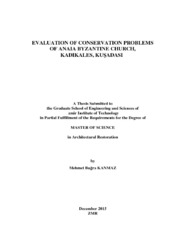Please use this identifier to cite or link to this item:
https://hdl.handle.net/11147/4578| Title: | Evaluation of conservation problems of Anaia Byzantine Church, Kadıkalesi, Kuşadası | Other Titles: | Kuşadası, Kadıkalesi, Anaia Bizans Kilisesi'nin koruma sorunlarının değerlendirilmesi | Authors: | Kanmaz, Mehmet Buğra | Advisors: | İpekoğlu, Başak | Keywords: | Historic preservation Anaia Church |
Publisher: | Izmir Institute of Technology | Source: | Kanmaz, M. B. (2015). Evaluation of conservation problems of Anaia Byzantine Church, Kadıkalesi, Kuşadası. Unpublished master's thesis, İzmir Institute of Technology, İzmir, Turkey | Abstract: | Anaia Church, which is thought to have been in use from the Early Byzantine Period to the Late Byzantine Period, is located in Kadıkalesi, Kuşadası. Kadıkalesi is a Byzantine Period fortification that it is thought to be built to protect harbour of Anaia ancient city, which was a bishopric throughout the Byzantine Period. Today, the three aisled basilical planned church is in state of ruin and excavations are on going in the area. The building reflects architectural planning, construction technique and architectural element features from the 5th century to the 14th century, was determined as the subject of this thesis to document and develop a conservation proposal. The study began with field survey and the building was documented with drawings and photographs. Planning, constrcution technique, architectural elements and the conservation problems of the building were evaluated and finally a conservation approach was developed in accordance with the data obtained throughout the study. In the analyses, it was seen that Anaia church shows parallel planning evolution that represents the features from the Early Byzantine Period to the Late Byzantine Period. The centrally located ambo in the nave and synthronon in the apse reflect the Early Byzantine Period features. The filling walls and toppled columns revealed in the naos were evaluated as physical effects and measures of earthquakes. Stepped pilasters in the northern and southern façade walls and recessed brick technique in the northern façade wall are the features of construction technique. The majority of the observed problems in the building are related with exposure to the atmospheric conditions since the roof of the church has not survived to present. Furthermore, it was observed that the temprorary protective shelter at the east and west end of the church, is inadequate. As a result, to conserve the Anaia Church as a cultural asset, drainage in the area, protective shelter, supporting of the arches and vaults, consolidation of the walls, conservation of the floor coverings and removal of humidity from the substructure were proposed. Anaia Kilisesi, Erken Bizans Dönemi’nden Geç Bizans Dönemi’ne kadar kullanıldığı düşünülen, üç nefli bir bazilikadır ve Kuşadası, Kadıkalesi’nde konumlanmıştır. Bizans Dönemi boyunca bir piskoposluk olan Anaia antik kentini koruma amaçlı inşa edildiği düşünülen Kadıkalesi bir Bizans savunma yapısıdır. Günümüzde kilisenin çatısı tamamen yok olmuştur ve alanda kazılar devam etmektedir. Mimari planlama, yapım tekniği ve mimari elemanları açısından 5. yy.’dan 14. yy.’a kadar özellikler yansıtan yapı, belgelenmesi ve koruma kararlarının geliştirilmesi amacıyla tez konusu olarak belirlenmiştir. Çalışma, arazi çalışmalarıyla başlamıştır. Yapı çizimlerle ve fotoğraflarla belgelenmiştir. Kilisenin, planlama, yapım teknikleri, mimari elemanları ve koruma problemleri değerlendirilmiştir, elde edilen veriler doğrultusunda yapının korunmasına yönelik bir koruma yaklaşımı geliştirilmiştir. Yapılan analizlerde, yapının planlamasının Erken Bizans Dönemi’nden Geç Bizans Dönemi’ne kadarki planlama anlayışlarına paralellik gösterdiği görülmüştür. Naosta merkezi konumlanmış ambo ve apsis bölümündeki synthrononun ise Erken Bizans Dönemi özelliklerini yansıttığı belirlenmiştir. Naosta görülen dolgu duvarlar ve devrik durumda ortaya çıkarılmış sütunlar depremlerin etkisi ve bu depremlere karşı alınmış önlemler olarak değerlendirilmiştir. Kuzey ve güney cephede görülen kademeli pilastırlar ve kuzey cephedeki gizli tuğla tekniği yapım tekniği özellikleridir. Yapının üst örtüsü günümüze ulaşmadığından, gözlenen problemlerin büyük bir kısmı atmosferik şartlara doğrudan maruz kalmasıyla ilişkilidir. Ayrıca yapınn kuzey ve güney ucunda inşa edilen geçici kısmi örtünün yetersiz olduğu belirlenmiştir. Sonuç olarak Anaia Kilisesi’nin bir kültür varlığı olarak korunması için alan içerisinde drenaj, koruyucu üst örtü, kemer ve tonozların desteklenmesi, duvarların sağlamlaştırılması, döşeme kalıntılarının korunması ve altyapıdaki nemin kurutulması önerilmiştir. |
Description: | Thesis (Master)--Izmir Institute of Technology, Architectural Restoration, Izmir, 2015 Full text release delayed at author's request until 2019.01.31 Includes bibliographical references (leaves: 265-275) Text in English; Abstract: Turkish and English xxv, 362 leaves |
URI: | http://hdl.handle.net/11147/4578 |
| Appears in Collections: | Master Degree / Yüksek Lisans Tezleri |
Files in This Item:
| File | Description | Size | Format | |
|---|---|---|---|---|
| T001441.pdf | MasterThesis | 350.16 MB | Adobe PDF |  View/Open |
CORE Recommender
Page view(s)
238
checked on Jul 15, 2024
Download(s)
126
checked on Jul 15, 2024
Google ScholarTM
Check
Items in GCRIS Repository are protected by copyright, with all rights reserved, unless otherwise indicated.